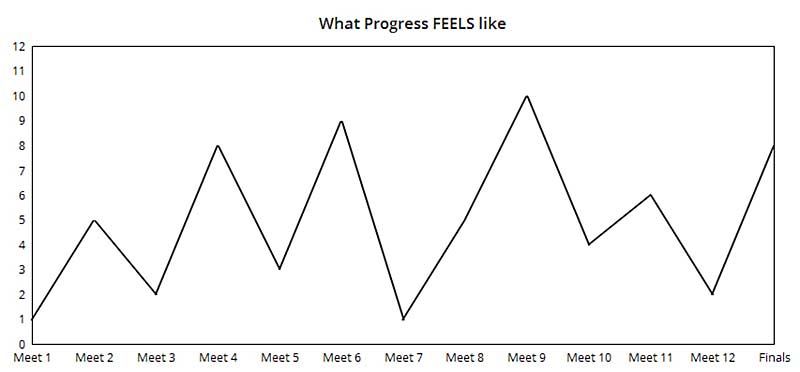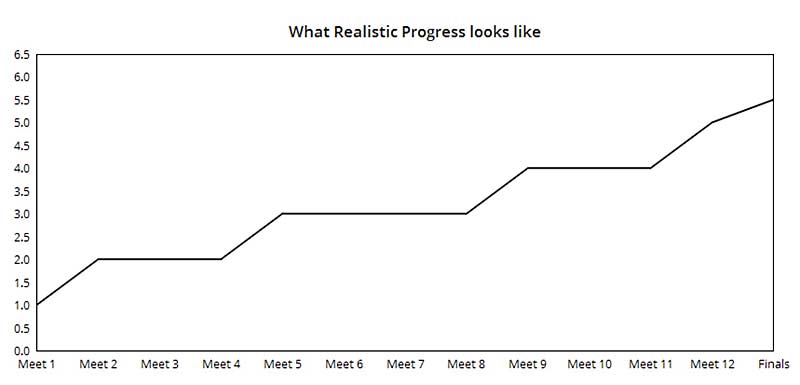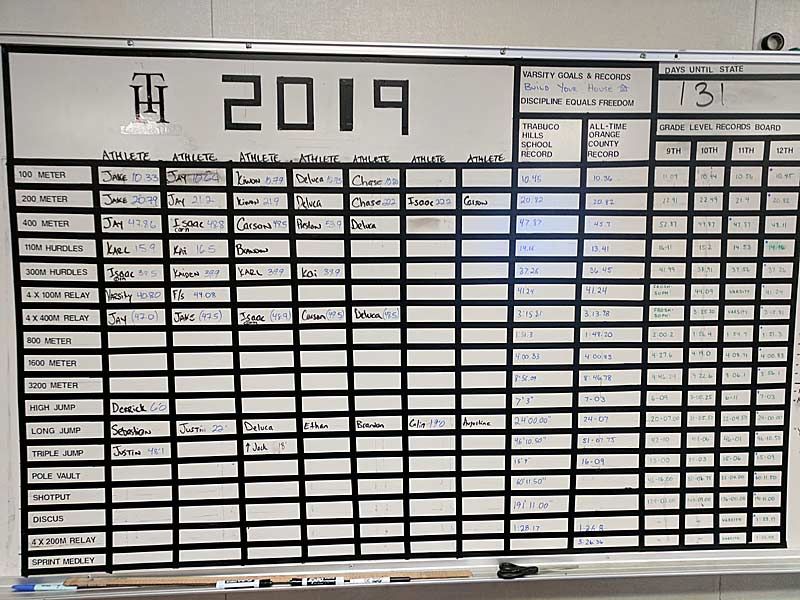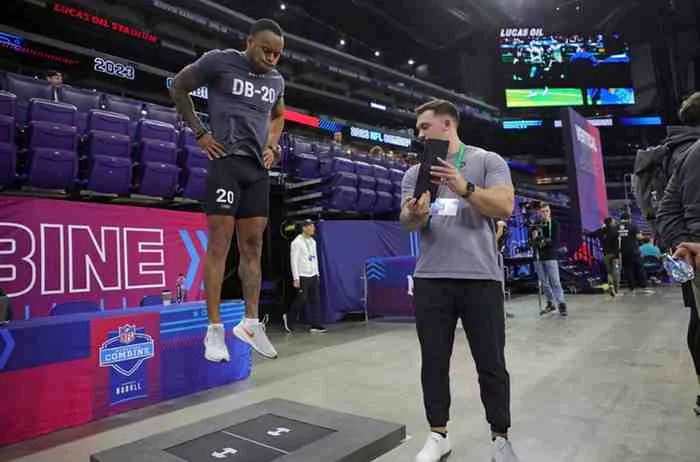[mashshare]
Too many athletes “float” through practices and entire seasons. They have no direction or purpose. They show up, most of the time, and get through whatever the coaches have for them that day. And their coaches become more and more frustrated by their athletes’ lack of focus toward the end of a season.
Bestselling author and leadership guru Michael Hyatt once wrote: “You have a choice in life. You can either live on-purpose, according to a plan you’ve set. Alternatively, you can live by accident, reacting to the demands of others. The first approach is proactive; the second reactive.”
If you’re reading this, chances are you’re not a coach who sits idly by and lets a season happen by accident. You probably have goals for your team. Athletes, however, are not solely motivated by the goals their coaches create for them. They need to have ownership of what they believe they can accomplish. As coaches, we can help our athletes set better and more meaningful goals, where they’re motivated by the process of achieving their desired outcome.
Why Set a Goal?
To use Brian Tracy’s words (from his book Goals! How to Get Everything You Want—Faster Than You Ever Thought Possible), “You become what you think about most of the time.” Goals are effective because they influence psychological states (such as self-confidence), direct attention to improve aspects of the tasks, mobilize effort, and increase persistence. A goal gives you a desired destination, gives you purpose, communicates expectations, helps you plan, communicates vision, and keeps you focused.
A good #goal is measurable, practical, shared, planned, and motivating, says @trabucotrack. Share on XA good goal is measurable, practical, shared, planned, and motivating. A bad goal is not measurable, not specific, too short, too complex, and not shared.
When leading my team in creating meaningful goals, I always start with the previous season. I show them what we created together and remind them of what they accomplished. It’s important to begin in a group setting and then have the athletes individually create their own goals. Teenagers are highly impressionable, and their peers’ judgments are very powerful. I use this force as accountability in their goal setting. Teammates will keep one another accountable day to day, eliminating the need for the coach to do it.
How Do You Write A Good Goal
- Think about where you want to go or what you want to accomplish
- Share with someone else and gather feedback
- Write your goal with a specific date and a deadline
When writing a goal, do this:
- Begin with the word To
- Add an action verb
- State the result
- Write your deadline (very important)
Examples:
- To run (verb) 10.9 in the 100m (result) by league finals (deadline).
- To complete over 70% of all passes to 5 different receivers before the end of the game.
- To vault 15’0 in the pole vault by state finals.
- To average 90% of made free throws this season.
- To bat over 0.300 with at least 10 home runs by the end of the season.
- To win league finals as a team by the end of the season.
It’s About the Process, Not the Destination
Goals give a destination and reveal where you want to go. But without a deadline, when are you supposed to arrive? This is why so many athletes float through their practices—without a deadline, there’s no accountability to stick with the plan. In athletics, procrastination in one’s training leads to undesirable results.
Without a deadline, athletes have no #accountability to stick with the goal plan, says @trabucotrack. Share on XCoaches, we need to teach our athletes how to create clear goals with the proper expectations on what the process of their progress will look like. The right perspective leads to clear expectations.
I highly recommend going through a weekly meeting on how to fall in love with the process of becoming great. Chop Wood, Carry Water: How to Fall in Love with the Process of Becoming Great by Joshua Medcalf is an excellent resource for this endeavor.
I use these charts for goals, and you can find similar illustrations in Chop Wood, Carry Water.

Every competition will not yield a new personal best. It’s unfortunate that many athletes believe they should improve every time they work hard. It’s important to educate athletes that having good goals is great, but the process of getting to those goals is what matters most. I find my athletes are unmotivated and discouraged after the first meet of the season if they didn’t see their lifetime personal best happen. As their coach, it’s imperative to change their perspective and help them see growth happen in the process.

As they move through the season, athletes think it’s less and less likely they will ever reach their goals when they feel so far away from them. The process of their training matters. Do they see themselves moving in the right direction? As the coach and leader, are you following along with them in their journey to give them a proper perspective?
Left alone, athletes will feel unmotivated, and resentment can build because they believe obtaining goals shouldn’t feel this way. Typically, this is where they question the coach and abandon plans because of impatience and the wrong perspective.

Casting this vision at the beginning before training begins will give long lasting perspective to the process. Perseverance in all moments will allow the athlete to take it one day at a time and feel like any setback will not determine the final goal. Grit is passion and persistence over a long period of time. We want to create athletes with grit, and grit is only developed in moments of adversity. It’s hard to live on a plateau of eventual success, yet this is not the time to give up or change the game plan. A clear understanding of what to expect from the process will yield athletes with grit.
Problem with Motivation
Any goal requires, if not demands, that athletes stay motivated in their pursuit of the desired destination. It’s vital that we, as coaches and leaders, understand those we lead. Today’s generation of young people is easily bored, socially connected to their peers, and proficient in technology. And they truly want to be challenged by their leaders. For more reading on similar findings, look into Motivating the Modern Athlete by Dr. Marty Durden.
I have interviewed over 2,000 students and athletes in 5 years about the effectiveness of servant-leadership coaching and how it impacts the motivation level of high school athletes. The survey was designed to determine which coaching traits served to motivate the athletes best. The seven traits surveyed were (listed alphabetically):
- Altruism—giving to others with no motive to gain something in return; kindness.
- Empowering others—developing and mentoring others; teaching you how to play the game.
- Humility—focusing on other people rather than oneself; meekness.
- Love—placing unconditional value upon the individual as a person and not what they offer to enable the coach to win more games; maternal or paternal affection.
- Service—willing to assist others; helpfulness.
- Trust—demonstrating confidence in others to succeed; keeping promises.
- Vision for the followers—helping team members to imagine their potential to succeed; helping others to establish goals.
The results of the survey indicate the coaching traits that provide the greatest motivational value are:
- Trust (41%)
- Love (17%)
- Empowering (15%)
- Vision (11%)
- Service (6%)
- Altruism (5%)
- Humility (5%)
An interesting conclusion from this study: young people are motivated by people they trust, who demonstrate love toward them, and who see their worth and seek to develop them.
By setting goals with your athletes, encouraging them throughout the entire process of a season, and helping them create a sense of self-accountability, coaches will see more athletes with grit reach their desired goals.
Publish Goals Publicly for Accountability
Goals need to be created by the coach and athlete together, not made by the leader and said to the athlete. When the coach and athlete both contribute to the process, the athlete feels like a collaborator, and motivation in the process is long lasting. When they don’t collaborate, athletes feel unmotivated in the process and lost in their pursuits.

Conclusion
It’s worth our time to develop meaningful goals that we create with our athletes. With this process, we’ll begin to see athletes become accountable for their own progress. Their perspective will focus on perseverance in the process of the goals they created. Because their good measurable goals with a deadline are public and published, sustainable motivation will flourish. We then get to encourage our athletes in the day-to-day training because they trust us as co-collaborators who seek to develop them under a framework of goals they believe in.
Since you’re here…
…we have a small favor to ask. More people are reading SimpliFaster than ever, and each week we bring you compelling content from coaches, sport scientists, and physiotherapists who are devoted to building better athletes. Please take a moment to share the articles on social media, engage the authors with questions and comments below, and link to articles when appropriate if you have a blog or participate on forums of related topics. — SF
[mashshare]




